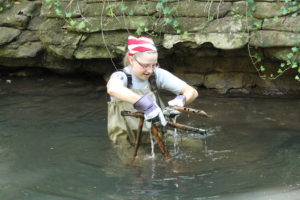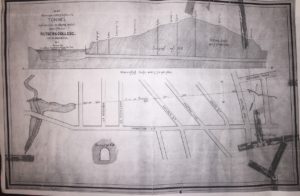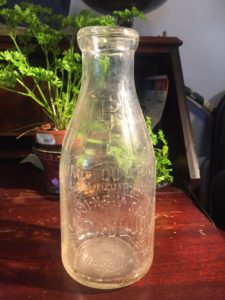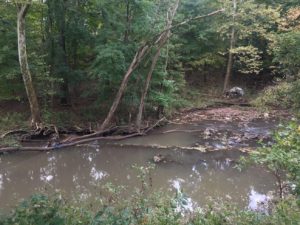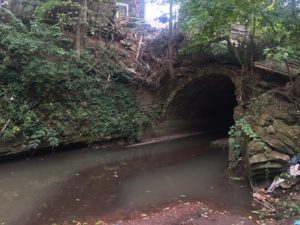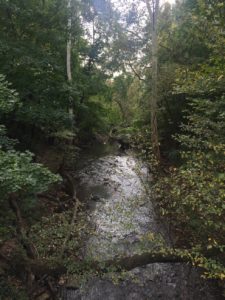Meet LRWP Board Member Amy Braunstein
Interview by TaeHo Lee, LRWP Fall 2018 Raritan Scholar
On the coldest, windiest day of October 2018, Lower Raritan Watershed Partnership Board Member Amy Braunstein and I met at Hidden Grounds on Easton Ave, a hidden café seven steps below street level, to talk about the LRWP’s new Streamkeeper Program. Amy is the Founder of Friends of Mile Run Brook, and is the LRWP’s first “Streamkeeper” – someone who has committed to stewardship of a local waterway in the Lower Raritan Watershed. Amy has served as Streamkeeper of New Brunswick’s Mile Run Brook for almost a year. Amy has a varied background. She did her undergrad at Rutgers, graduating in 2008 and she recently passed the bar after completing a law degree. She is now practicing law in Newark. While a student, she was an organizer involved in various political campaigns on campus including Tent State and Democrats for Change. She also worked with Food and Water Watch in New Brunswick. She has been an environmentalist since she was a Girl Scout when she had the chance to participate in community clean-ups, but Food and Water Watch reawakened her environmentalism as an adult.
TaeHo: Where are you from in Lower Raritan Watershed, and how did you get involved as Streamkeeper for Mile Run Brook?
Amy Braunstein, cleaning up Mile Run Brook (photo: John Keller)
Amy: During my senior year of college, I came upon Mile Run Brook while exploring with friends, and fell in love with the stream. I live right next to it now, on Woodbridge Street. We are right on the municipal border between New Brunswick and Franklin, but also the county line between Middlesex and Somerset. Mile Run and the Raritan are natural boundaries.
Living next to Mile Run, I got a pretty good view of a lot of the garbage that was either being dumped in there or washing in there. So I started reaching out among friends and online, just trying to organize some small cleanups on my own. After doing enough cleanups, I wanted to learn more about the actual water quality. And through that I met Heather Fenyk who was active on the New Jersey’s Waters and Save the Raritan River facebook group pages. I asked if anybody had water quality testing kits, and Heather found my Friends of Mile Run Brook facebook page and reached out to me and was like “would you want to help out on these [water quality monitoring] projects?” and then she asked me to help out with formation of the Lower Raritan Watershed Partnership. It’s fine to do things on my own, but working with the Partnership brings so many more resources to the stream, and opportunities to learn more and get more involved in larger watershed issues.
T: Could you tell me what a Streamkeeper is?
A: A Streamkeeper is somebody that has committed to monitoring the vitals of a particular stream, and to providing stewardship for the ongoing health of that stream. This includes the water quality monitoring that we do, things like measuring temperature, speed, depth, and turbidity, and taking a more holistic approach to the activities going on nearby that might impact the stream and possible areas of improvement. It also includes organizing clean-ups and helping people who want to get involved. That is finding folks that would want to help with this effort. A Streamkeeper takes a stewardship role, above and beyond taking data by looking at who is using the stream in terms of not only human recreation but also fish and wildlife and figuring out things that need improvement.
T: Tell me about Mile Run Brook.
A: There is a fascinating history with the stream. Have you seen the documents about the old mine?
T: No!
A: There was an old copper mine that started near where my house is. Somewhere in those backyards was an access tunnel. And it went all the way down past where the new Hillel building is on the Rutgers College Ave campus. The tunnel ran underground. This was back in the Colonial Era. I think it closed up maybe by the end of the 1700s, definitely by the mid-1800s. But that mine shaft is still there. Workers still find it every now and again during construction projects. I don’t know if you’ve ever seen the movie, the Goonies, but it’s an ongoing joke that they found a treasure map and a series of mine shafts and tunnels under this suburban town. And it’s a fantastical adventure with pirate ships and such. We joke about the copper mine in New Brunswick and say “Oh! We got a Goonies’ situation down there!”
Copy of the map that depicts the copper mine and its mine shaft in New Brunswick
T: (laughter) So, the mine is all filled up now? Or…
A: No, it’s abandoned. Although when they were constructing the Hillel building on College Ave, they found old pickaxes and parts of the dissolved mine. Unfortunately, the reason why this mine opens up over by Mile Run Brook is that, before modern science and human understanding of our effects of pollution on the water systems, people thought water will flush out any garbage left behind and make the area clean, just all of the mine waste and stuff. At one clean up, we found, we’re pretty sure, it was a piece of old coal slab run off from the mine, from the smelting process. And the whole area behind my house is actually a landfill that was capped in the 1930s, I think. And on the Woodbridge St., all of the houses along it were built in the 1950s. Folks would use the stream as a garbage dump. There are pits down there where they found old glass, where they just had been throwing old bottles. Some of these bottles are, in fact, very old. As old as New Brunswick, even. Some of these are hand blown glass. Also – have you seen the name Paulus around? It’s a dairy company in the 1800s in central New Jersey. We found milk bottles from the dairy. This was back when a fleet of milkmen was delivering milk to people.
T: And you found it during a cleanup?
A: We found it one day when I was just kind of walking around with my boyfriend. Sometimes we walk down there to explore. We’d seen some local folks who would walk down with a bucket and then come back out with a bucket full of old looking bottles. And we’re like, “what’s going on down there?” It’s a fascinating history. You know, there’s been people in and around the stream for a long time.
Old hand-blown glass milk bottle from Paulus Dairy that Amy found from the stream.
T: What are current challenges of your Streamkeeper work?
A: The constant challenge is the garbage that is washed in with the stormwater from residential areas. Storm drains lead to our local waterways and a lot of refuse that gets into our streams that way. Also, unfortunately, there is a lot of dumping. I think that doing anti-littering and anti-dumping outreach in a way that is effective and that actually gets people thinking about the effects of their actions is a challenge.
Another challenge more specific to my spot, my geographic proximity along Mile Run Brook, are homeless folks who live there from time to time. Doing outreach with them has been difficult, because there is a lot of fear. When I approach them, they will hear me coming and leave. There’s fear of authorities. There’s fear of having all their stuff stolen. The LRWP has done some great outreach work to these communities in advance of clean-ups. For example, we let them know what’s going on, invite them to join us, and treat them like human beings. The LRWP worked with a social worker to develop outreach material to give them that talks about shelter and food and employment and other social service resources. But, working with those communities, it’s going to be a challenge.
We do want to make that bridge, because they can also be great allies, and there are folks that live near the stream, and it shelters them, and they can be another set of eyes. There’s a lot that we share in common. And I think sometimes people just call the police on them and they get pushed out of the spot and it’s unfortunately a long-term problem in our society that needs to deal with. It’s like the lack of housing and shelter for everybody that needs it. These are kind of like big society problems, but also they relate back to the work with Mile Run Brook. Because the way the things are now… a lot of the homeless people don’t want to be seen and so they will just hide all the evidence of them being there like garbage and food wrappers and all that stuff. And the way they hide them is to just throw it down the ravine.
T: What are some responsibilities that property owners who live adjacent to streams have to maintain the adjacent water bodies?
A: There are two levels: there is legally what is required of them; and then I would say there is kind of like morally and ethically what it is required.
Legally, people cannot discharge any fluids or liquids into the streams. Sometimes folks will be doing home model repair and will not take the proper precautions when emptying radiators or changing the oil. And that stuff can get straight into the stream and have an impact. Also, we have a responsibility to not put any other materials into our local streams. One common mistake that property owners make is just pushing all the leaves, branches, sticks, and debris off of their property and down the ravine into the stream. I mean I think that their thinking is that It’s all natural, it’s not going to make an impact. But this is illegal. And the cumulative impact of everybody pushing all that debris down in there, which would otherwise be scattered evenly on the ground ultimately becoming fertilizers in the waterway, would clog the streams and create stagnant pools.
Another issue confronting New Brunswick residents and homeowners is there is a lot of garbage just in general, and sometimes… you live in New Brunswick, right? So you see that garbage gets blown by the wind. So you can clean up your yard but then stuff can blow in and, I mean, really, it’s on each of us to go through and pull that garbage out of our yard. It is not fair. I didn’t throw it there. It blew in. But that stuff ultimately does make its way into either the trees getting caught or into the streams. So homeowners have responsibilities to remove the garbage or litter, before it is blown into these areas.
Morally and ethically, there is only so much that the law can require people without being coercive or going too far and saying how you live your life. But, I feel like people should look at the impact that their actions make such as how they mow their lawn or what kind of plants they choose to grow. So, where I am at the ravine is very, very steep, and there is an erosion issue. And there is natural plantings and natural ways to just getting those root systems in place to hold the bank in. Or also leaving old or fallen trees undisturbed, they really serve their purpose in streambank reinforcement. Thinking about the impact of each of our actions when it comes to aesthetic improvements to houses, sometimes we will take them in and there will be a bunch of trees and they’ll want a yard. We don’t get those trees back, not in our lifetime. Maybe in our kids’ lifetime if we’re lucky. So, taking positive actions to improve the areas is something that I think falls more into the area of morals and ethics.
One thing the LRWP advocates for that is amazing are pollinator gardens. These are projects the LRWP does in partnership with the New Brunswick Environmental Commission. They will plant milkweed and things that we know that these species are being impacted need in order to survive. Homeowners can easily plant pollinator gardens or native plant species, and they can make choices to not use fertilizers and pesticides. I think doing those kinds of things is really a moral responsibility at this point… Unless each of us tries to make an effort, there is coming a time where there is not going to be enough space for all the creatures of Earth’s biodiversity.
T: What would you like to accomplish in the next five years as a Streamkeeper?
A: let’s see… in 5 years as a stream keeper of Mile Run specifically, I would love for Mile Run to be a stream where people can wade in and fish in and play in as a recreational opportunity. Right now there are issues with stormwater runoff. There used to be a lot of industries along Mile Run – there was a perfume factory and other industrial dischargers dumping directly into the stream. Now the issue is stormwater runoff bringing in trash and other wastes through the stormwater system. Identifying what and where these pollutants are going in and stopping them at the source is goal #1. Maybe we can get Mile Run to be a place where people can really play. I would like to see frogs and lizards and other indicator species return to Mile Run. I would love to see a pathway along the Mile Run so that the members of the public can have a green space to go and recreate in. The more people use it or know it’s there the more they appreciate it. But if it’s just a hidden spot, it’s easier to get trashed and it doesn’t have value. So I would love to see some recreation spaces opened up over there.
T: As a Streamkeeper, do you have any messages to others who may be interested in becoming Streamkeepers?
A: Just explore your streams! Take a look around. All the work I have done to clean-up the stream has benefited me tenfold in terms of my enjoyment of a beautified space. And there is still a lot of hidden beauty in our streams; animals you wouldn’t expect to see. Honestly getting outside and being in nature it’s like… your kids are gonna love it. With a little bit of elbow grease, if we all do a little bit, it’s amazing how beautiful it can be. So, my message would be “go out there, take a look, and get to know the place!”
Following the interview, Amy took me to Mile Run Brook and gave me a brief tour of a section of the stream, from which her house overlooks. We had to be careful around what looked like a homeless spot and spotted a white-tailed deer darting away.
View of Mile Run Brook from Amy’s backyard. On the right of the bank is a homeless community.
Segment of an old tunnel that Mile Run runs through.
Even after many clean-ups, trash gets blown in, washed in, and dumped into Mile Run Brook

